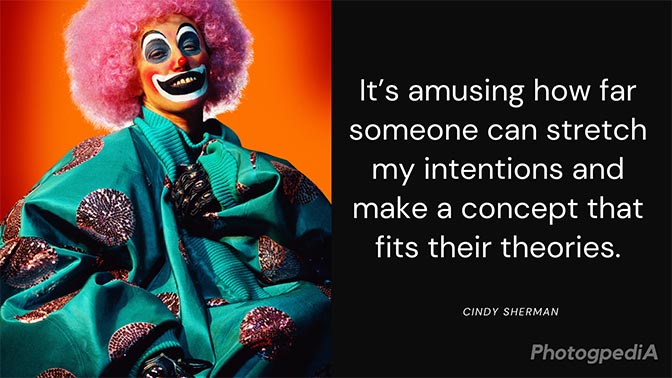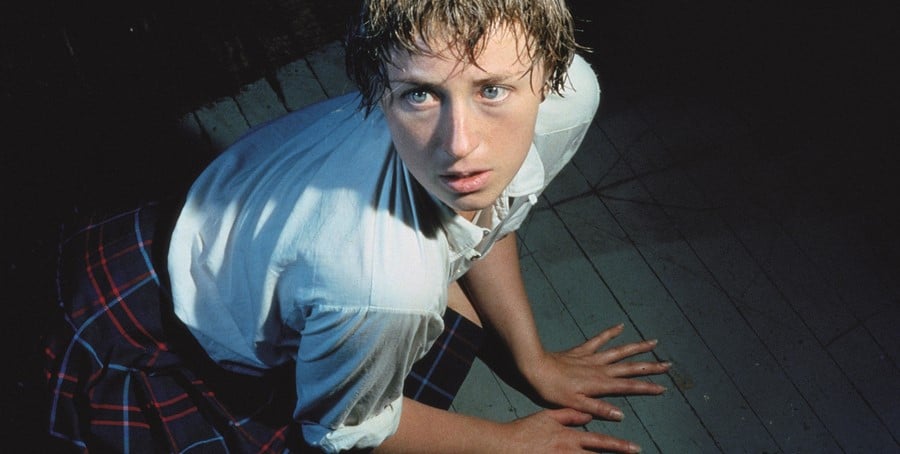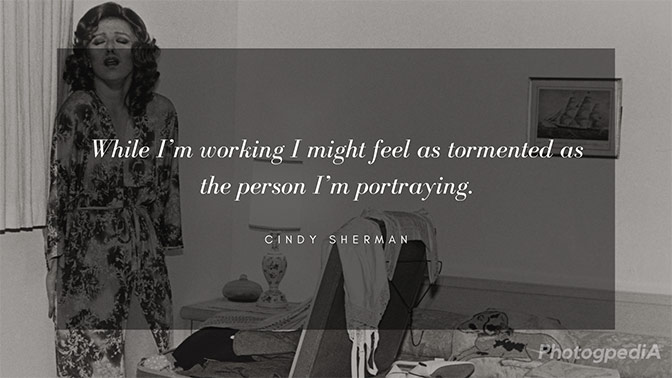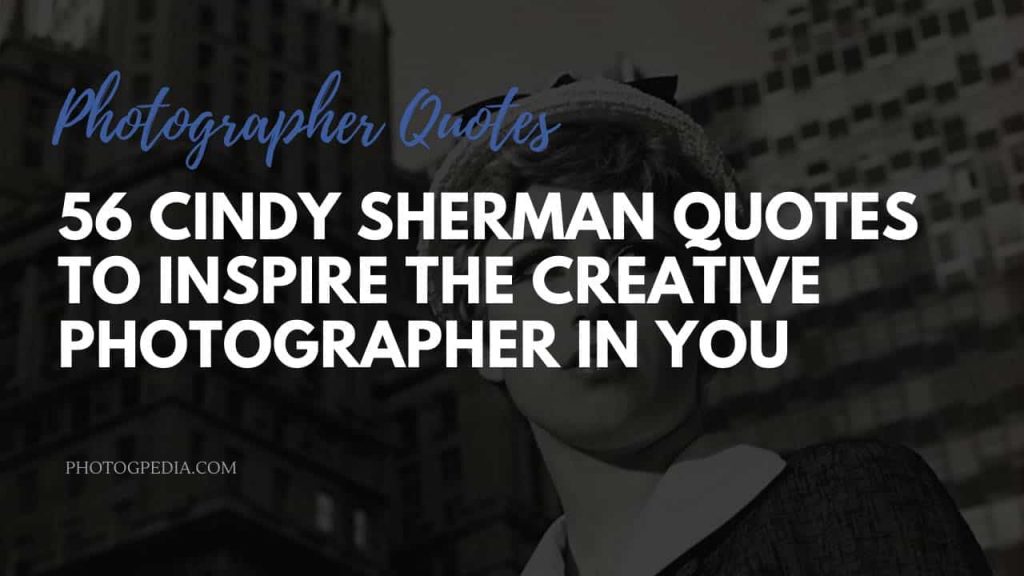Looking for Cindy Sherman quotes? Then you’ve come to the right place. Below, we have compiled 56 of Sherman’s best quotes to inspire you and help take your photography to the next level.
If you haven’t done so already, we recommend reading our Cindy Sherman master profile article to learn more about her career, photography, techniques, and much more.
Cindy Sherman Quotes
The still must tease with the promise of a story the viewer of it itches to be told.
I like making images that from a distance seem kind of seductive, colorful, luscious and engaging, and then you realize what you’re looking at is something totally opposite. It seems boring to me to pursue the typical idea of beauty, because that is the easiest and the most obvious way to see the world. It’s more challenging to look at the other side.
Nowadays, with digital printing, it’s so easy to make everything perfect, which is not always a good idea. Sometimes the mistakes are really what make a piece.
We’re all products of what we want to project to the world. Even people who don’t spend any time, or think they don’t, on preparing themselves for the world out there – I think that ultimately they have for their whole lives groomed themselves to be a certain way, to present a face to the world.
People are always trying to find the next groovy thing, and it hasn’t gone back to painting… I’d like it to go back to painting. I’m sick of all this photography and video. There’s so much of it, it’s almost annoying.
The models have always been the least interesting thing about fashion.
Being able to make a living doing something one truly loves to do – is my definition of success.
Photography and Art
I didn’t want to make what looked like art in terms of painting; I wanted to make something that looks mass-produced and I didn’t want it to have anything to do with art theory. I wanted it to look like anybody would understand it because it’s from a movie and maybe I saw that movie.
One reason I was interested in photography was to get away from the preciousness of the art object.
I didn’t have any interest in traditional art.
I was meticulously copying other art and then I realized I could just use a camera and put my time into an idea instead.
I think people are more apt to believe photographs, especially if it’s something fantastic. They’re willing to be more gullible. Sometimes they want fantasy. Even if they know it’s fake they can believe anything. People are accustomed to being told what to believe in.
I didn’t really have ideas of what I wanted to do with painting. That was when I thought, “Why am I wasting my time elaborately copying things when I could use a camera?
I like the idea that people who don’t know anything about art can look at [my art] and appreciate it without having to know the history of photography and painting.
Painting was still the big thing, but I was less and less interested in it even though I started out in that department; I was into conceptual, minimal, performance, body art, film – alternatives.
I didn’t set out to establish an alternative. No one really did – expectations were a lot lower than you see with people coming out of art schools today. I did want to do something different; I was bored by what was going on in art and particularly in painting, but I didn’t think I was actually going to make a difference. We all would have been happy just to have a show somewhere.
I got nervous when my work was starting to become popular, so I started making things that would challenge someone to hang it over their sofa.
I didn’t want to make “high” art, I had no interest in using paint, I wanted to find something that anyone could relate to without knowing about contemporary art. I wasn’t thinking in terms of precious prints or archival quality; I didn’t want the work to seem like a commodity.
Sherman on Interpretation and Meaning
I am always surprised at all the things people read into my photos, but it also amuses me. That may be because I have nothing specific in mind when I’m working.
My intentions are neither feminist nor political. I try to put double or multiple meanings into my photos, which might give rise to a greater variety of interpretations…
The work is what it is and hopefully, it’s seen as feminist work, or feminist advised work, but I’m bot going to go around espousing theoretical bullshit about feminist stuff.
I would read theoretical stuff about my work and think, “What? Where did they get that?” The work was so intuitive for me, I didn’t know where it was coming from. So I thought I had better not say anything or I’d blow it.
I don’t analyze what I’m doing. I’ve read convincing interpretations of my work, and sometimes I’ve noticed something that I wasn’t aware of, but I think, at this point, people read into my work out of habit. Or I’m just very, very smart.
The reason I wasn’t titling them besides the fact that I never felt very much like a wordsmith is… I didn’t want people to have a preconceived notion of what they’re supposed to imagine this character to be.
I didn’t think of what I was doing as political. To me, it was a way to make the best out of what I liked to do privately, which was to dress up.
Early in my career, a critic said that I needed to “explain” the irony in my work, suggesting that I needed to add text next to the images to help people understand what I was trying to say.
At first I was dismayed that I wasn’t making work with a clear enough message. That’s when I realized that that was the exact opposite of what I wanted to do – that I wasn’t responsible for a misinterpretation of my work, that there should be some ambiguity to it. They either got it, or they didn’t.
It’s amusing how far someone can stretch my intentions and make a concept that fits their theories.

The Queen of the Self-Portrait
Everyone thinks [that my photographs] are self-portraits, but they are not meant to be. If I photograph myself it’s because I can push my own limits to the extreme. I can make from each shot a work as heavy, as clumsy or as stupid as I want.
I feel I’m anonymous in my work. When I look at the pictures, I never see myself: they aren’t self-portraits. Sometimes I disappear.
People assume that a self-portrait is narcissistic and you’re trying to reveal something about yourself: fantasies or autobiographical information. In fact, none of my work is about me or my private life.
The role-playing was intended to make people become aware of how stupid roles are, a lot of roles, but it’s not all that serious, perhaps that’s more the moral of it, not to take anything too seriously.
When I was in school I was getting disgusted with the attitude of art being so religious or sacred, so I wanted to make something which people could relate to without having read a book about it first. So that anybody off the street could appreciate it, even if they couldn’t fully understand it, they could still get something out of it. That’s the reason I wanted to imitate something out of the culture, and also make fun of the culture as I was doing it.
It has nothing to do with me. I work with myself, that’s my material somehow, but the finished photograph has more to offer than reflections of my “personality”.
My photographs are certainly not self-portraits or representations of myself, though unfortunately people always keep saying they are.
I have this enormous fear of being misinterpreted, of people thinking that the photographs are about me, that I’m really vain and narcissistic. Then sometimes I wonder how it is I’m fooling so many people. I’m doing one of the most stupid things in the world which I can’t even explain, dressing up like a child and posing in front of a camera trying to make beautiful pictures. And people seem to fall for it.
Untitled Film Stills
I don’t think of it as real photography because I don’t think people who like real photography think of it that way. People who are real photo fans like the early film stills, the black and whites that seem like real vintage photography, or there are people who complain about how big they are, like, “Who does she think she is?” It’s just the medium I chose to work with.
I didn’t want to make what looked like art. Film has always kind of been more influential to me than the art world.
To pick a character like that was about my own ambivalence about sexuality – growing up with the women role models that I had, and a lot of them in films, that were like that character, and yet you were supposed to be a good girl.
Some people have told me they remember the film that one of my images is derived from, but in fact I had no film in mind at all.
I didn’t care much about the print quality. The photographs were supposed to look like they cost fifty cents.
Truthfully, I’m a little sick of these pictures [the Untitled Film Stills] – it’s hard for me to get excited about them anymore. It’s funny to see some of them now.
Throughout my life, I’ve tried to keep looking different, so my hair has been all different colors, all lengths and styles. As a result, a lot of these characters look like me in the periods of my life since I shot the Film Stills… Occasionally I’ve felt that as I’ve gotten older I’ve come to look more like some of them. It’s kind of scary – I was always trying to look like older women.

Cindy Sherman Quotes on Ideas
If I knew what the picture was going to be like, I wouldn’t make it. It was almost like it was made already… the challenge is more about trying to make what you can’t think of.
In horror stories or in fairy tales, the fascination with the morbid is also, at least for me, a way to prepare for the unthinkable… That’s why it’s very important for me to show the artificiality of it all, because the real horrors of the world are unmatchable, and they’re too profound.
When I prepare each character I have to consider what I’m working against; that people are going to look under the make-up and wigs for that common denominator, the recognizable. I’m trying to make people recognize something of themselves rather than me.
Believing in one’s own art becomes harder and harder when the public response grows fonder.
I just got those at the Paris flea market, and I don’t know what I’m going to use them for, but it seemed like they had the potential for something. I love weird stuff; a good, weird flea market anywhere is really my favorite place to be.
I’ll see a photograph of a character and try to copy them on to my face. I think I’m really observant, and thinking how a person is put together, seeing them on the street, and noticing subtle things about them that make them who they are.
My ideas are not developed before I actually do the pieces.
I see humor in almost everything, in even the grotesque things, because I don’t want people to believe in them as if they were documentary that really does show true horror. I want them to be artificial, so you can laugh or giggle at them, as I do when I watch horror movies.
Every time you have to come up with a new body of work for a new show, you’re aware that people are just ready to rip you apart, they’re just waiting for you to fall or make the slightest trip up.
[My work is] maybe about me, maybe not wanting to be me and wanting to be all these other characters. Or at least try them on.
Cindy Sherman’s Working Process
I’m good at using my face as a canvas… I’ll see a photograph of a character and try to copy them on to my face. I think I’m really observant, and thinking how a person is put together, seeing them on the street and noticing subtle things about them that make them who they are.
I can’t work without it [music]. And it has to be the right kind, because if it’s not then I get into a bad mood. I work with a remote so that I can change CDs instantly if I need to.
It’s just me, and a mirror and a camera and a backdrop, and that’s about it. I’ve always felt that I’m able to be a little more experimental because no one is around if it doesn’t go well.
Once I set up, the camera starts clicking, then I just start to move and watch how I move in the mirror. It’s not like I’m method acting or anything. I don’t feel that I am that person. I may be thinking about a certain story or situation, but I don’t become her. There’s this distance. The image in the mirror becomes her – the image the camera gets on the film. And the one thing I’ve always known is that the camera lies.
When I’m cooking, I’m just following a recipe – I’m being told what to do. When I’m working on my photographs I have to make up my own sort of rules. Sometimes I have a vision of what I want but mostly I’m guided by what I don’t want.
I think of becoming a different person. I look into a mirror next to the camera… it’s trancelike. By staring into it I try to become that character through the lens… When I see what I want, my intuition takes over.
When I do work, I get so much done in such a concentrated time that once I’m through a series, I’m so drained I don’t want to get near the camera.
The way I see it, as soon as I make a piece I’ve lost control of it.
I’d never even thought about compromise when I worked in my studio. The major distinction is in the priority of who I ultimately wanted to please: myself or the audience.
While I’m working I might feel as tormented as the person I’m portraying.

What’s your Favorite Cindy Sherman Quote?
Have a favorite Cindy Sherman quote from the list? Let us know in the comment section below.
Don’t forget to bookmark this page, or print it out, and refer to it next time you need some inspiration. Also, don’t forget to share it with others through the usual channels (social media, forums, websites, etc).
To learn more about Cindy Sherman’s photography, we recommend reading our Cindy Sherman master profile article. To see more of her remarkable photography, check out the Cindy Sherman image archive on the MoMA website.
Looking for more words of wisdom from master photographers? Check out the quotes section of Photogpedia for more great photography quotes.
More Quote Articles:

